Matador Network's Blog, page 1028
August 23, 2019
Frankfurt Airport: Best places eat
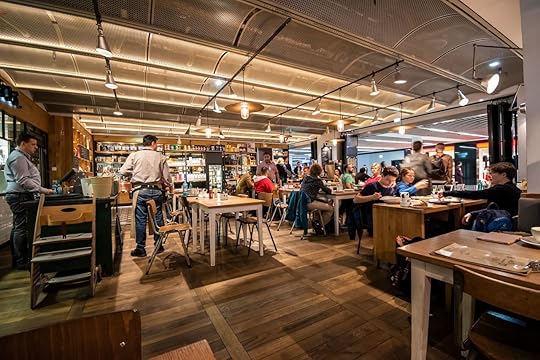
Your experience eating and drinking at the Frankfurt Airport completely depends on which terminal you’re in. While that’s true at many airports, it’s especially true in mid-sized ones like this. Terminal 1 passengers will have better luck when it comes to options, while Terminal 2 passengers might want to consider getting ready early so they can eat beforehand. The plus side is that there’s a decent place to get a beer pretty much no matter where you are (meaning pretty much everywhere serves good German beer).
Of course, there’s always the option to ditch airport proper and head to the Sheraton Frankfurt Airport Hotel. It’s connected to Terminal 1 and has two restaurants (Flavors for international cuisine, Tavern for German fare), the Sports Bar (cocktails and beers), and the Davidoff Lounge smoking room (complete with a choice of Cuban cigars).
If your goal is to stay in Terminal 1 or Terminal 2 of the Frankfurt Airport, however, these are the best places to eat and drink.
Terminal 1 pre-security
Thong Thai: A local German Thai food chain. Reasonable prices for noodle dishes and protein options like duck. It’s as fast as the US-based fast-food chains around it and something different for those tired of the same old fast-food options.
Kamps: German chain with pastries and coffee that’s serviceable for a quick stop.
Terminal 1 A
Heberer’s: A classic German bakery with pastries and pretzels to load up on your carb fix before your flight. It’s fast and the coffee is good, which is more than you can say about a lot of airport places.
Lucalino: Italian bistro open for breakfast, lunch, and dinner. The breakfast menu has croissants and other breakfast pastries along with coffee. Pizza and pasta round the menu out from lunchtime on.
Tangente: A German restaurant focused on breakfast and lunch. There’s a bar with a healthy choice of beers and cocktails, and the food menu has German sausage plates, sandwiches, and salads. Cheese and pretzels are also on the menu, naturally.
Hausbar: Quick to-go food that’s on the healthier side. Smoothies available both with or without alcohol. A fast alternative to the more sit-down friendly (and more expensive) Hausmann’s next door.
Terminal 1 B
Goethe Bar: A German deli and bar complete with beers and bar food that’s named after famed writer Johann Wolfgang von Goethe. For breakfast, there are options like pancakes with Nutella, croissants, espresso, and muesli. The deli serves your typical sandwiches, while the bar has well-priced beers (for an airport). It’s situated right in the middle of the shops if you get tempted by that type of thing.
Cosi Asiate: A Thai place with vegan options and a beer menu that includes non-German specialties like IPAs. There are fried noodles cooked in a wok with your choice of protein, as well as udon soups, tom yum, and miso. The portions are large, so come hungry if you’re looking to order a curry or fried dish.
Kuffler & Bucher: A Frankfurt Terminal 1 classic that’s been around since 1999. For those who are used to the quick turnaround of US restaurants (let alone airport restaurants), the age alone makes this a place of interest. The brasserie serves German and continental European food like duck, fish, and noodles. There are also vegetarian options and a to-go service for those in a rush. If you have some time to kill, pull up a spot at the large full-service bar.
Terminal 1 Z
Lucullus: Italian food with a bar. There aren’t many other options in Z, but this place has serviceable pizza and sandwiches. It has a reputation for being slow — something to consider if in a rush.
Terminal 2 pre-security
Ludwigs: German cuisine like wiener schnitzel, currywurst, and goulash with a focus on fresh ingredients.
Vito: Italian restaurant with pizza and pasta. Nothing here will knock your socks off, but it’s a solid option for the food court surroundings.
Terminal 2 post-security
Mosch Mosch: A Japanese noodle bar with ramen, rice dishes, and curry. Also salads if you’re looking for something on the healthy side.
Food Society: Continental European fare like German sausage, currywurst, and burgers along with Italian pasta, pizza, and salads. There’s a full bar. 

More like this: Why Frankfurt is the most underrated city in Germany
The post The best places to eat and drink in Germany’s Frankfurt Airport appeared first on Matador Network.

August 22, 2019
Bragging about travel is the worst
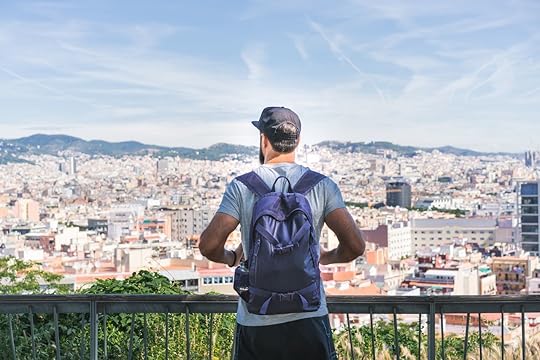
I strained my calf a while ago. Scintillating, I know, but there’s a point here.
A friend I hadn’t seen in a while noticed me limping when I went to visit her, and she asked me how I hurt my leg.
“Oh,” I said, “I was on this cruise ship off the coast of Spain, and I decided I’d run some laps, you know, to stay in shape or whatever. So I’m just looking out at the view of Barcelona, and I get all excited and start running too fast and, bam, my calf just seizes up.”
She looked at me like I’d just told her I hurt it playing whiffle ball. After a longer-than-normal pause she said, expressionless:
“You could have just said ‘I hurt it running.’”
And this was when I realized that I had become a place dropper. Like its equally insufferable cousin, the name dropper, a place dropper will interject some far-off locale into a story that has nothing to do with the place, in hopes that whoever is listening will think said dropper is cool and worldly. Or, hopefully, ask them more questions so they can talk a liiiiittle bit more about themselves and their experience.
And it’s poor, poor travel manners.
As travel becomes more common, learning not to place drop is an essential social skill. And it’s a skill a lot of people lack without even realizing.
Take my friend who recently told me he’d been discussing with his mom — while in Bali — what to get his dad for Christmas.
Was it a line of aromatic oils and a new outlook on mindfulness? No? Still a tie? Ok, then. So Bali was about as important to the story as the brand of toothpaste he used that morning.
But, of course, my follow up question wasn’t supposed to be about Christmas presents at all. It was supposed to open a floodgate of info about his trip to Bali, which I had about as much interest in hearing as I did in his thoughts on radial tires.
He, of course, had no way of knowing this. Because the flood of fake support people get on social media makes us believe any time we talk about somewhere trendy, everyone’s ears will perk up.
But here’s the thing, self-proclaimed world traveller (because you spell it with two “l”s now): It’s neat that you’re a globetrotter and collect passport stamps like stamps on your coffee rewards card. But like a lot of enviable achievements, most people who aren’t able to do it generally don’t want to hear about it. And dropping “in Maui” at the end of a story about going out to buy hemorrhoid cream makes you look about as tasteful as the guy who feels the need to mention he went home with the waitress when recommending a good Martini bar.
Some might say, “Hey, Matt, chill out. People like hearing my stories of international exploration!”
No, actually, they don’t. The fact is, much like most people never wanted to see your vacation photos when you got home in the days before social media, they have no interest in your envy-inducing tale of overwater bungalows in the Maldives. Unless they specifically ask. It’s in the same family as how much money you make, how well your kids are doing in school, or your keto diet. People may listen politely and ask questions when they run out of small talk, but generally, it’s a lot of one-sided bragging. And that’s why God invented Instagram.
You might also say, “But remembering where I was is how I remember a good story!’
Fair enough, so here’s a simple rule:
If your location is integral to the point of a story, then place name away. But if the story would be the same anywhere, and you mention it anyway, you’re place dropping, and you’re the worst.
Take the person who recently felt the need to tell me about an enlightening conversation they had with a former Marine about US foreign policy… at a beach bar in Australia. Knowing Marines, I’d guess said Devil Dog would have spouted the same bar-fueled rant in Sandusky, Ohio; Dallas, Texas; or really anywhere he found someone who would sit still for 90 minutes.
Now, had you had the same conversation in, say, Okinawa, Japan, where thousands of Marines are stationed and have a unique viewpoint on US relations there, naming where you were might have some relevance.
Otherwise, cool on you, bro. You went to Australia.
Like people who attended Ivy League schools and don’t perpetually mention their alma mater (Looking at you, Duke. HARD), people who travel don’t need to mention that hilarious time they got a parking ticket… in Paris. Place dropping is both tasteless and tacky, and as I learned when visiting my friend — in a place I don’t need to mention — sometimes it’s best to just say, “I hurt it running.” 

More like this: Thanks, ‘influencers!’ Visiting natural landmarks is now pure hell
The post appeared first on Matador Network.

Travel in Italy by scooter or Vespa

Italy’s varied landscape lends itself perfectly to exploration by scooter, or a Vespa if you really want to look like an Italian local. Its hairpin coastal roads, gentle hills, and mountain passes are best appreciated on two wheels, not stuck inside a car, and scooter riding gives you the freedom to stop off spontaneously along the way. Here are some itineraries from around the country that take you over mountain ranges in the Alps, around rocky coastlines in Puglia, and through rolling, verdant landscapes in Tuscany. And being Italy, there’s always a curious hilltop village, local restaurant, or country villa for pit stops on the way.
1. Salento, Puglia

Photo: mjols84/Shutterstock
At the very base of the stiletto heel of Italy’s boot lies the area of Salento. Its coastal roads can make for a three- to four-day trip, allowing plenty of time for exploring sea caves and eating fresh seafood. Start from San Cataldo on the east and head south down the eastern coastline. This side of Salento’s coast is characterized by dramatic cliffs, rock formations, and grottoes. Stop at Grotta della Poesia, a natural swimming pool formed by erosion, and Sant’Andrea with its monumental rock formations and sea arches. Continue down to the most southern point of Puglia, Santa Maria di Leuca, and then back up the west coast, which is dotted with sandy beaches like Le Maldive di Salento. Finish in Gallipoli, a town protruding out into the sea, and make sure you try the local specialty — raw red prawns of Gallipoli.
2. Amalfi Coast, Campania

Photo: IgorZh/Shutterstock
Unlike the Salento coastline, this route is not for the inexperienced rider or anyone with vertigo. This stretch of road along the beautiful Amalfi Coast is an exhilarating combination of hairpin bends, dizzying views down to tiny sailing boats far below, and battles with local buses that careen along at terrifying speeds. Start in the town of Positano. Admire the bougainvillea bedecked streets, but if it’s high tourist season, don’t stay too long. Carry on to Furore, a village of a few houses and vineyards on terraces rising vertically up from a fjord, and on to Conca dei Marini, a village surrounded by lemon groves with a sort of natural terrace that overlooks the sea. Amalfi, once one of the Four Maritime Republics of Italy, is very attractive but also very busy. Pause in Ravello, instead, to enjoy the Villa Rufolo gardens and finish in Vietri sul Mare, the heart of the Amalfi coast production of bright, artistic ceramics and home to the Museum of Ceramics.
3. Southern Tuscany
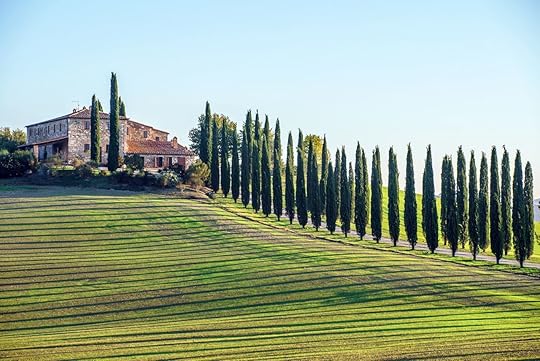
Photo: Shebeko/Shutterstock
When it comes to Italy’s most popular tourist region, Tuscany, it is almost a prerequisite that you go around by scooter or motorbike. A car just feels cumbersome. With lots of small roads and tracks through the countryside, you can avoid traffic and go scenic. The southern area of Tuscany provides several days’ worth of natural and man-made attractions to pepper your days of riding. There are three natural hot springs here. Saturnia features white terraces of iridescent blue pools while Bagni di San Filippo has dramatic white cliffs of built-up calcium deposits. Bagno Vignoni is a town whose main piazza is actually a large rectangular pool of thermal water. Visit the hilltop towns of Montepulciano, for excellent wine and leather goods, and Pitigliano, whose houses built on a rocky outcrop sit above a network of underground caves.
4. Stelvio Pass, South Tyrol

Photo: Andrew Mayovskyy/Shutterstock
Focusing more on the experience of driving itself, the Stelvio Pass, or SS38, connecting Bormio to South Tyrol is known as one of the greatest driving roads in Europe. Its series of electrifying bends that zig-zag mercilessly down the southern side, or as Top Gear’s Jeremy Clarkson puts it, “15 miles of asphalt spaghetti draped on an Alp,” is one of the most famous images of the road, though the other side of the pass is often preferred by motorcyclists as it’s less crowded with cyclists and tourists. Be careful of another kind of traffic, though, in the form of mountain goats. If you take your eyes off the road for a second (that’s all you get), you’ll see thrilling drops over the side and sheer rugged mountains above. At the top, there is a viewpoint and a stand selling sausages, an essential part of the Stelvio experience.
5. Le Langhe, Piemonte
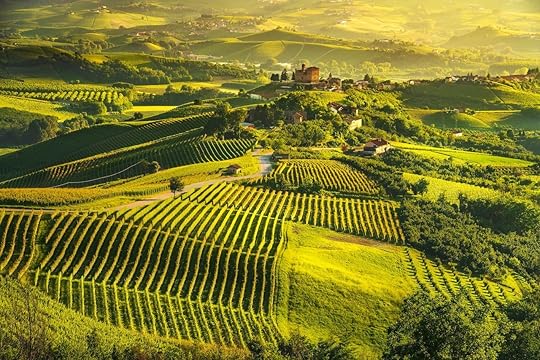
Photo: StevanZZ/Shutterstock
Still in the north, but to the extreme west, the Langhe area of the Piemonte region is usually highlighted for its gastronomic merits, as it is the land of white truffles and hard-hitting wines like Barolo and Barbaresco. But it is also crisscrossed with well-tarmacked, meandering roads that wind through verdant vineyards carpeting the hills. The landscape has been given UNESCO World Heritage status for the preservation of its winemaking culture, described as “an archetype of European vineyards.” A slow ride through this artistically cultivated landscape passes towns like Alba, the home of the truffle, and Neive, voted one of the “most beautiful villages in Italy.”
6. Riviera del Brenta, Veneto
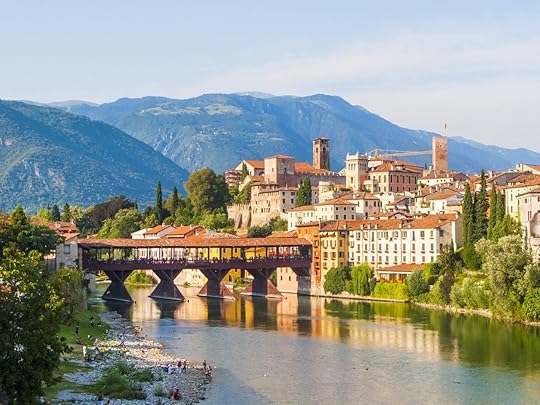
Photo: travelview/Shutterstock
For a short day trip, instead, bikers can look to the Riviera del Brenta in the Veneto region. The River Brenta connects Venice on the sea with the city of Padua inland. Along the stretch of river are a dozen elegant villas that were the country houses of various Venetian nobility. A pleasant day can be had pottering along the road following the river and stopping at some of these prestigious houses. The most famous is probably Villa Pisani at Stra. It boasts 114 rooms, the largest of which features a ceiling by 18th-century painter Tiepolo. It has spectacular gardens with a maze, and it was once owned by Napoleon for a while.
7. Parco Nazionale del Gran Sasso e Monti della Laga, Abruzzo
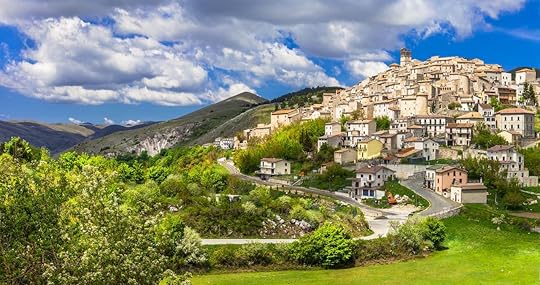
Photo: leoks/Shutterstock
Finally, national parks are always a safe bet for some attractive driving roads and captivating scenery. In the region of Abruzzo, the Gran Sasso national park, one of the largest protected areas in Europe, is famous for its rocky, snowy (depending on the season) peaks like the brooding Gran Sasso massif itself or the Corno Grande, the highest peak on the Italian peninsula. A popular bikers’ pit stop in the province of Aquila is Ristoro Mucciante, a simple wooden structure with benches outside and grills smoking away with sizzling pork chops and local specialty arrosticini (lamb skewers). Stop off at the nearby medieval hilltop town of Castel del Monte, a huddle of houses rising up the steep slope with narrow, precipitous streets. 

More like this: Italy has the most diverse wine grapes in the world. Here’s where to start.
The post The best places in Italy to explore by scooter appeared first on Matador Network.

Best free things to do in Helsinki
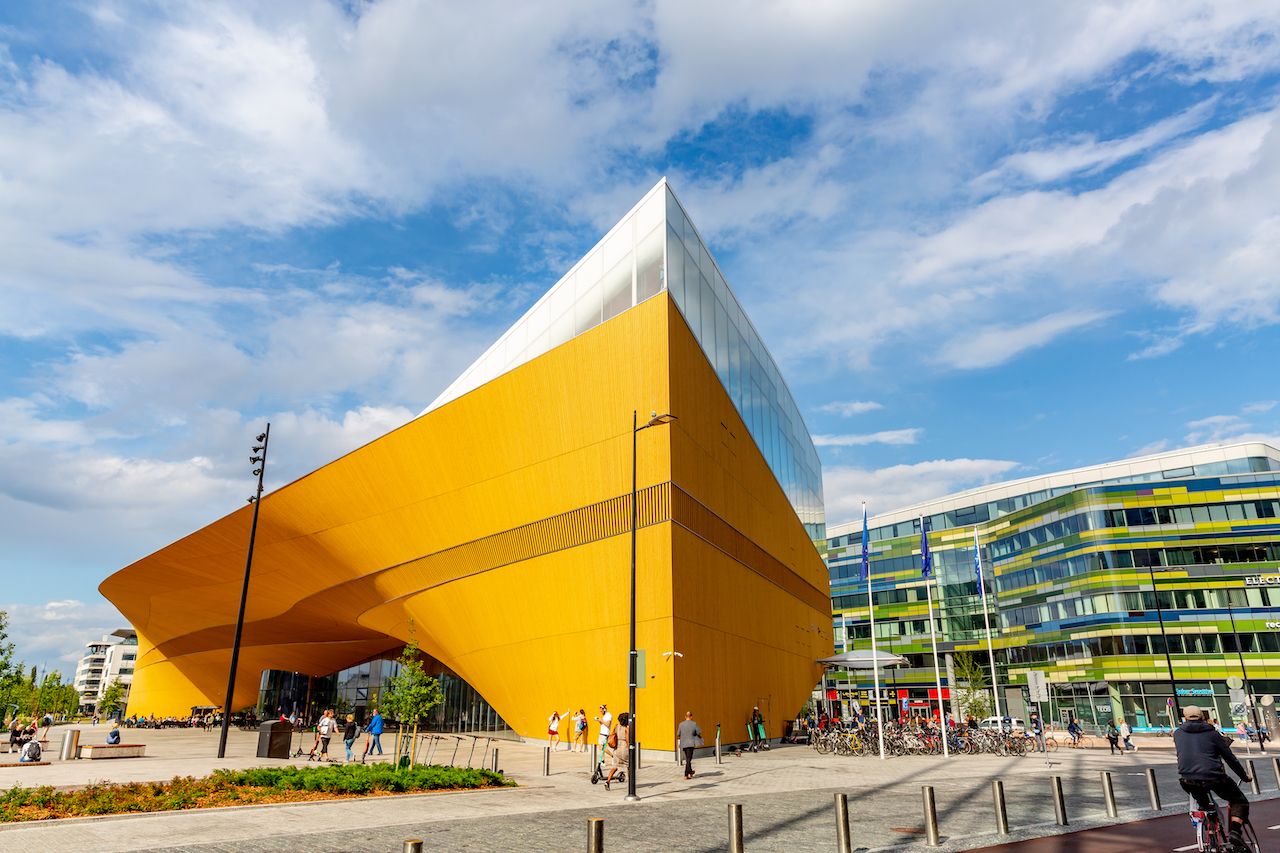
As in neighboring Scandinavian destinations, Finland’s capital isn’t known for cheap prices. But, for those who know how to look, there are actually plenty of ways to enjoy the city without breaking the bank. Many of Helsinki’s most popular attractions — including the main churches and the Suomenlinna Fortress Island — are free to visit, and it doesn’t end there. From museums to an alternative sauna experience, here are 10 things you can do in Helsinki for nothing, or nearly nothing.
1. Visit a museum for free.

Photo: Mikko Ryynanen/Shutterstock
Many of the city’s top museums are completely free of charge. Start your tour with a visit to the Helsinki City Museum, located smack in the middle of the historical city center. Both the permanent and rotating exhibitions have a common theme and are built around the everyday history of Helsinki and its inhabitants. You can also immerse yourself in the history of trams or the working class or visit Burgher’s house, the oldest wooden building in central Helsinki. It’s worth checking out the free entry dates for other museums, as well. For example, Kiasma, the museum of modern art, offers free entry on the first Friday of every month.
2. Pop into the National and Central Libraries.

Photo: Subodh Agnihotri/Shutterstock
Helsinki is home to nearly 40 public libraries. The mother of them all is the recently renovated National Library, originally completed in 1840. A fine example of early 19th century Empire architecture, the library has an especially impressive main hall with a beautifully decorated dome, pillars, and wooden bookshelves. Like many other historical buildings in central Helsinki, the library was designed by architect Carl Ludwig Engel.
Library lovers should also pay a visit to the new Helsinki Central Library Oodi, located just next to the central railway station. Take a break and read a book, play some boardgames, or enjoy the views on the rooftop terrace. Oodi is also home to a cinema, a music studio, and a playground for kids, making it a bit like an urban living room for city dwellers.
3. Take a ferry to Suomenlinna Fortress Island.

Photo: Oleksiy Mark/Shutterstock
One of the most popular attractions in Helsinki is Suomenlinna, a former fortress island and a UNESCO World Heritage site. Appreciated by locals and travelers alike, this island is a popular destination for historical walks, picnics, and swimming. To get there, you’ll only need to hop on a ferry departing from Market Square. The journey takes about 15 minutes and, because it’s part of the public transport network, only costs about $3.10 one way. When visiting the island, do note that it’s home to about 800 people who live there throughout the year. Respect their privacy by staying on the marked paths and taking your litter with you. Other tips for a sustainable visit can be found on the official website.
4. Unwind in Nuuksio National Park.
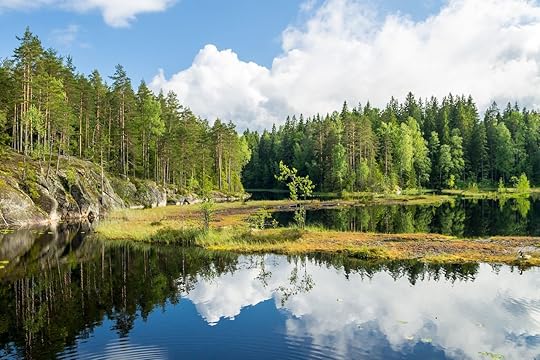
Photo: Alexanderphoto7/Shutterstock
The 17-square mile national park of Nuuksio is just an hour away from Helsinki and, like the fortress island, can be easily reached by public transport. The best way to enjoy the park is to head to Haukkalampi and do one of the marked hiking tours which start from there. If you’re feeling a bit more adventurous — and have your own tent or hammock — you can extend your trip for an overnight stay.
There are no camping fees, and the camping spots have campfire facilities and covered cooking areas in case it happens to be rainy. Thanks to the idea of jokamiehenoikeus, or “everyman’s right” to roam, forage, fish with a line and rod, and spend time in the natural areas — a concept shared with Sweden and Iceland — the berries and mushrooms found in the national park can be picked by everyone. So pack a container in case you spot some Finnish forest treats, such as bilberries, lingonberries, funnel chanterelles, and other wild mushrooms.
5. Get to know the local food culture in markets.

Photo: Popova Valeriya/Shutterstock
Helsinki has three market halls, all unique in their own way. Most visitors will find their way to Market Square and the nearby Old Market Hall, both full of local produce, as well as traditional souvenirs. Those looking for something more local should head to Hietalahti Market Hall, an old market hall turned into a hub of restaurants.
Pick your favorite from the many tasty and affordable lunch options, ranging from traditional Finnish salmon soup to Japanese ramen. During summer weekends, you’ll also find a popular flea market outside. The third market hall, the eastern Hakaniemi Market Hall, is currently under renovation, but all vendors can be found at the temporary glass building on the Hakaniemi Market Square.
An essential part of the experience in Helsinki is sitting down for torikahvit, a cup of filter coffee and a sweet pastry, such as a korvapuusti (cinnamon bun) or munkkipossu (sweet flat doughnut filled with jam). These traditional market cafes, usually located in orange tents, can be found on both the central and Hakaniemi market squares.
6. Discover Kallio, Helsinki’s hipster neighborhood.
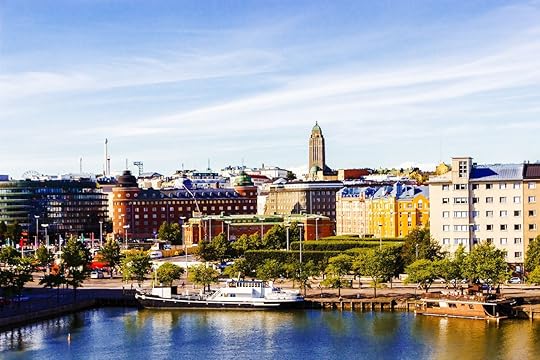
Photo: Kateryna Synelnyk/Shutterstock
Venture out to the east to Kallio, Helsinki’s equivalent of Brooklyn. Formerly a working-class neighborhood, Kallio has undergone a transformation into a lively area filled with cozy cafes and brunch spots, hip restaurants, bars, and music venues. It’s still rough around the edges, though, so you’ll also find plenty of blue-collar karaoke bars, happy hour beers, and adult stores.
For a complete Kallio experience, enjoy brunch at the record-store-slash-cafe Tanner before moving on to a glass of natural wine at the trendy wine bar Wino. Finally, head out to an old-school karaoke bar like Tenkka or Roskapankki, which literally means “trash bank.” Both venues are Kallio institutions known for their early opening hours — because hey, who wouldn’t want to have a pint and belt out some tunes at 9:00 AM?
7. Enjoy the atmosphere and free rides at the Linnanmäki Amusement Park.

Photo: Kingarion/Shutterstock
Located on top of a rocky hill in Alppila, the Linnanmäki Amusement Park has a unique charm, as it is the oldest of its kind in Finland. Even though most people come here for a whole day, it’s easy to pop in for a quick visit as there’s no entrance fee, and you can even ride a couple of the rides for free. Although most of the free rides are more suited for kids, the Panorama tower is fun for adults too and will take you more than 170 feet high, providing a spectacular panorama over the city. And if you happen to be in Helsinki in October with your loved one, don’t miss the annual Festival of Lights, a popular date destination for couples.
8. See the churches.
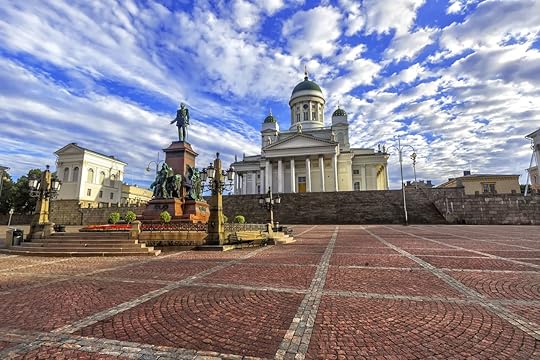
Photo: May_Lana/Shutterstock
Take a break from the bustle of the city and pop into one or more of Helsinki’s main churches. The bright white Helsinki Cathedral on the Senate Square is a landmark not to be missed. After enjoying the serene and simple interiors, do as the locals do and spend some time sitting on the steps leading up to the church. Fun fact: The steps also acted as the seats for a concert by indie rock band Arcade Fire in 2010.
A bit further to the west in the Töölö neighborhood, the Temppeliaukio Rock Church has a unique atmosphere, as it has been excavated right into solid rock, and the daylight only enters the building from a ceiling window. There’s usually an entrance fee of just over $3, but on Wednesday afternoons, the church can be visited free of charge. Finally, complete your church tour with a visit to the red-brick Eastern Orthodox Uspenski Cathedral, overlooking the city from a hill in Katajanokka, and the small wooden Kamppi Chapel of Silence, located between the main shopping centers in the city, Kamppi, and Forum.
9. Have a picnic at the Winter Garden Glasshouse

Photo: Popova Valeriya/Shutterstock
Although most people will time their visits for the summer months, many of Helsinki’s attractions can be enjoyed throughout the year. One of them is the Winter Garden, a glass greenhouse full of exotic plants and flowers. Enjoy a moment under the palm trees, read a book, or bring your own snacks to have a small picnic among the greenery. If the weather is nice, take a stroll around the adjacent Töölönlahti Bay, a popular spot for runners, cyclists, and Sunday walkers.
10. Get sweaty in a free sauna.

Photo: Sompasauna/Facebook
No trip to Finland would be complete without a good old sweaty sauna session. There are plenty of paying public saunas in Helsinki, but if you’re tight on budget and ready to experience something a bit different, try the free, self-service Sompasauna in Kalasatama. This quirky example of the Finnish sauna culture has been around since 2011, built and still maintained by volunteers. Bring along your own sauna beverages, towel, and swimsuit, but don’t necessarily expect to see the locals wearing one — Finns are very open-minded towards nudity when it comes to saunas. 

More like this: The best Helsinki bars that are only open in summer
The post 10 free things to do in Helsinki appeared first on Matador Network.

Most beautiful castles in Romania
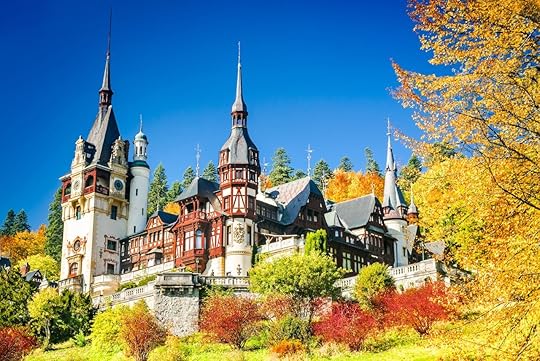
Romania is mainly famous for one thing: Dracula. Bram Stoker’s vampire was supposed to have lived in a castle perched on a rock in the Transylvania region of Romania, making the region appealing to bookish visitors and those in search of some thrills. Nevermind the fact that the author never visited the country and that Bran’s Castle was picked as the residence of the blood sucker only because it vaguely fitted the description provided in the 1897 literary work. While Bran Castle is definitely worth checking out — no matter the reason — it is far from being the only one in the country. Romania is home to more castles, citadels, and fortresses than outsiders expect to find in this part of Europe. Here are nine of the most amazing castles in Romania you didn’t know existed.
1. Hunyadi Castle

Photo: omihay/Shutterstock
Once the residence of medieval Hungary’s famous king — Mátyás Hunyadi, also known as Mathias Corvin — the castle known as Hunyadi or Corvin Castle was built in its present form by János Hunyadi, his father and the ruler of Transylvania, in the 15th century. An architectural masterpiece of the Renaissance-Gothic style, it’s got everything you’d expect from a medieval castle — a drawbridge over a rushing river serving as a moat, high buttresses, inner courtyards, thick walls, tall towers and pointed turrets, bastions, and windows and balconies ornate with stone carvings.
One of the castle’s most impressive features is the Knights Hall, decorated in marble, featuring impressive octagonal columns and tall arches, housing armors, cannonballs, and a statue of János Hunyadi. Used as a dining hall on special occasions, it also served as a trial place for the enemies of the kingdom. Though surrounded by an industrial Communist-era town, the castle still has a true medieval feel and was used in recent years as a setting for movies like Ghost Rider 2 with Nicholas Cage filmed in 2011, among others. The castle is open for visitors, but times and ticket prices vary, so check the website before you go.
2. Fagaras Fortress

Photo: Calin Stan/Shutterstock
Sitting in the center of the town of Fagaras, surrounded by a moat inhabited by swans, the Fagaras Fortress was built in the 13th century. The fortress has seen its share of battles but has never been conquered. The surrounding, deep moat is only one reason for it; the fortified outer wall that came after it was also a serious line of defense while five towers protected the heart of the edifice. The fortress was used as a political prison during Romania’s communist years in the mid-20th century.
Though defense might have been the main reason for building the fortress, rulers of Transylvania also used it as their residence. They added elegance and luxury, though not much of this remains today. Still, its grandeur and architectural beauty merit a visit. Open for guests, the Fagaras Fortress has a large history museum. It’s open Tuesday through Sunday, but since hours vary, check the site for opening times.
3. Rasnov citadel

Photo: Balate Dorin/Shutterstock
Perched on a rocky mountain top above a town of the same name, the Rasnov Citadel is all about defense. Built in the 13th century by the Teutonic Knights of German-Saxon origin, its main purpose was to protect the southern border of Transylvania from invasion of the Tartars. A peasant-citadel, the fortress was designed as a refuge for people of three villages, represented by the three roses on its coat of arms.
Surrounded by high walls, nine towers, two bastions, and a drawbridge, its architecture and location offered such a strong defense system that the Rasnov citadel was never conquered by force. It fell once to Transylvania’s own ruler when those living there rebelled against him. Today the Rasnov Castle is a major tourist attraction — as proven by the large, ugly, Hollywood-style “Rosnov” sign by the fortress — and it’s accessible by car, bus, or cable car from the town below.
4. Bran Castle

Photo: cge2010/Shutterstock
Bran Castle is the most famous and most-visited castle in the country, thanks to Stoker’s novel, Dracula. Even if you won’t find evidence of Count Dracula in Bran Castle, the castle is a neat spot to check out. Finished in 1388, it was built to defend Transylvania’s borders. Incorporating the rock it sits on in its design, it has unusual asymmetric towers and turrets. The present lavish interior is the work of Queen Marie of Romania, who renovated it and turned it into a royal summer residence, adding an elevator, a guest house, and other amenities after Transylvania became part of Romania in 1920. Inherited by her daughter, Princess Ileana, the castle became state property for a while when the communist regime took over in 1948. After using it as a museum until the fall of communism in 1989, the state returned the castle to Princess Ileana’s descendants, who still own it today. Open for visitors as a museum, it is a popular tourist attraction.
5. Peles Castle

Photo: /Shutterstock
Peles Castle, built in 1875 as a hunting estate for King Carol I of Romania, sits in the middle of a lush green forest at the foothills of the Bucegi Mountains of the Carpathians. Used as a summer residence for the royal family, the castle has multiple towers and 160 rooms, many of them dedicated to different cultures — Turkish, Moorish, French and Florentine, among others. The castle hosts one of the most valuable collections of art, with over 2000 paintings, hand-painted, stained glass, and crystal chandeliers. But its most impressive collection is in the Armory Room, where 4,000 pieces of weapons and armor are displayed.
Fully powered by electricity produced by its own power plant, built in 1883, the castle had running water, both hot and cold; central heating; and a central vacuum system. It even had a small elevator for the royal family in the foyer. Its own 60-seat Royal Theater Hall, decorated with paintings and wall frescoes by world-famous Gustav Klimt, hosted the first film projection in the country. The castle became state property in 1948 as Communism came to Romania. Returned to the royal family after its fall, the descendant of the king kept it as home of the Peles National Museum.
6. Sighisoara citadel

Photo: Balate Dorin/Shutterstock
Still inhabited, Sighisoara is a beautiful and very well-preserved medieval walled city. Built in the 12th century, then extended and strengthened in the 15th, it was designed with defense in mind, featuring 14 towers and a few bastions. Nine of the towers still stand though not all are open to the public. Dominating the historic center at 210-feet high, the clock tower with its multi-colored tiled rooftop became the symbol of Sighisoara. Built in the 14th century by the city council, it was a simple gate tower until the rooftop had to be replaced following a fire in 1676. The Baroque rooftop as we see it today, with the colorful tiles and five turrets with bulbs, was finished in 1677. During the renovations, the clock, showcasing carved wooden figures, was added, as well as a meteorological clock that still predicts the weather on its highest, central turret.
The citadel enclosing the historic center of Sighisoara was named a UNESCO heritage site in 1999. Stroll through the town then visit the clock tower and the museum inside. Take a behind-the-scenes look at the clock with the wooden figures, and walk out on the balcony for a great view of the city. Though opening hours vary, you can enter the tower daily between 10:00 AM and 5:00 PM daily, except on Mondays, for a small fee.
7. Rupea citadel
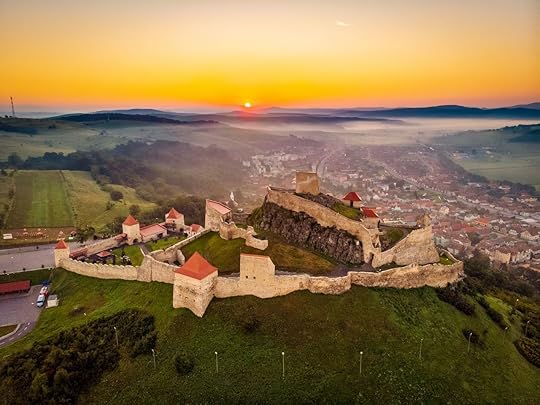
Photo: Calin Stan/Shutterstock
Built in the 13th century, perched above the town with the same, the Rupea Citadel spirals the hill it sits on like the shell of a snail. Built for three stages of defense, it features the lower, middle, and higher citadels, each with its own walls, towers, and inner buildings. With 10 square and pentagonal towers, characteristic for the region, the citadel was built to offer long-term refuge to the villagers in time of siege.
Though looking at it you’d think the citadel was impossible to conquer, it fell into the hands of the Turks a few times. But it wasn’t the enemy who demolished it. A devastating fire burned it down in 1643, and the Transylvanian Saxons who had built it, abandoned it. A few years later, in 1790, a severe storm demolished it further, and it sat abandoned for a few centuries. During the communist years, it was ready to be demolished so as to mine the basalt underneath, but since it proved to be too much work, the citadel survived. Reconstructed in 2013, it is open for visitors.
8. Deva citadel

Photo: Stefan Sorean/Shutterstock
The medieval Deva citadel, dating from the 13th century, sits on top of an ancient volcano in the Western Carpathians. Though a small citadel, Deva was important in stopping invasions of Transylvania because of its location overlooking the Mures River and the surrounding valley. Its long history involves being the property of kings and queens, princes and princesses of Transylvania, changing hands often, though Turks also conquered it. In the second half of the 17th century, it lost its military importance and became a prison. By the end of the 18th century, it was auctioned off, and the new owner took everything of value and left the citadel in disrepair. Though sitting in ruins, the citadel saw one more battle during the 1848 Hungarian fight for independence from the Habsburg rule. The citadel can be visited anytime, and there is no entrance fee. You can either hike up to it on a path through the surrounding protected forest or take a cable car up the hill.
9. Alba Iulia (Alba Carolina) Fortress

Photo: Calin Stan/Shutterstock
In its present form, dating from the beginning of the 18th century, the Fortress of Alba Iulia is one of the most beautiful examples of Vauban-style military architecture. Featuring seven bastions connected by walls of the same height, the inner fortress, also called the curtain wall, was designed to follow the shape of the terrain it sat on — in the case of Alba Iulia, this resulted in a shape of a seven-cornered star. Entrance to the citadel was possible through six richly ornamented gates, placed on the defense lines. But this impressive fortress was the third on the site, expanding an older one, dating from the 10th century, which stood on the site of an even older one, dating from the Roman times. During Romania’s communist years, the fortress fell into total disrepair; however, in recent years, most of it was restored, and today you can walk through three of its original gates. 

More like this: This is the happiest cemetery in the world
The post 9 amazing castles you didn’t know existed in Romania appeared first on Matador Network.

Everest plastic ban
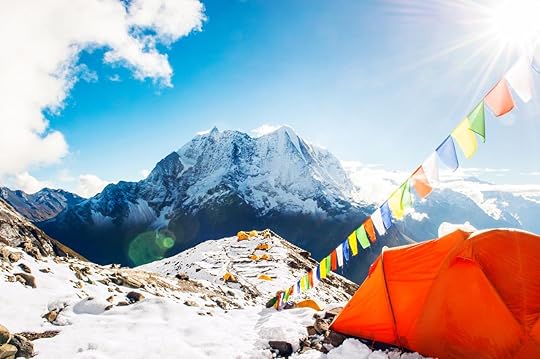
Mount Everest is tackling its most serious issues with draconian efficiency these days. Only a few days after Nepal has decided to implement strict rules for those wanting to obtain a climbing permit for Everest, it’s now going after the region’s waste problem with similar rigor.
Climbers have been leaving an incredible amount of trash, including mountaineering equipment and even human waste, behind on the mountain. A BBC report drawn from a statement by the Tibetan authorities revealed that three clean-up operations in spring 2018 resulted in the collection of eight tons of waste.
To put an end to this disgusting habit, Nepal is taking a no-nonsense approach to the issue, completely banning single-use plastics in the Khumbu Pasang Lhamu municipality starting in January 2020.
The ban applies to all plastic drinking bottles and plastic that’s less than 30 microns in width. No exact penalty for violating the ban has been announced yet.
Earlier this month, an advisory panel recommended that anyone who wants to summit Everest is required to be accompanied by an experienced Nepalese guide and must have previously climbed a Nepalese peak of at least 21,300 feet. The point of the new rules to obtain a permit is to keep climbers safe and reduce the negative impact of too many tourists in the region. 

More like this: Nepal makes training mandatory for Everest climbers
The post Nepal bans single-use plastics in the Everest region appeared first on Matador Network.

Titanic wreck decaying rapidly
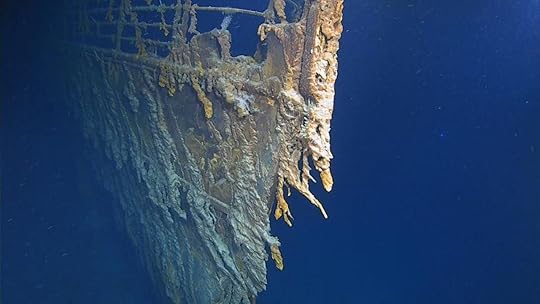
It’s been 15 years since anyone dove down to check up on the Titanic wreck, and apparently it’s not doing so well. In early August, a team of explorers made five dives in the North Atlantic to check out the ship, only to find that the wreck is being rapidly destroyed by metal-eating bacteria, salt corrosion, and deep ocean currents.
Previous expeditions revealed that iron-eating microbes had colonized the wreckage, and that the whole thing would eventually dissolve into a fine powder. Some have estimated that there would be nothing left of the ship by 2030.
The RMS Titanic has been laying at the bottom of the Atlantic Ocean, at a depth of 2.5 miles, since 1912. The ship, thought insubmersible, hit an iceberg during a voyage from Southampton to New York City and sank, killing more than 1,500 people, which is over half of all passengers and crew members.
A documentary film of the wreck by Atlantic Productions, the first ever 4K images of the ship, is currently in the works. 

More like this: Underwater art exhibit made of plastic surfaces in the Florida Keys
The post Titanic divers discover the shipwreck is decaying at an alarming rate appeared first on Matador Network.

Best Bangkok street food

If you go to Bangkok and spend the entire trip eating inside restaurants, you’re doing it wrong. In most cities, street food is considered a novel alternative to the traditional restaurant, but in Bangkok, street food is as traditional as it gets. And since there are food carts and stands around literally every corner, it can be pretty daunting to figure out where to eat and plan your Bangkok culinary experience in advance. Luckily, some Bangkok markets are similar to Michelin-starred restaurants when it comes to name recognition. Much like farmers markets, vendors appear on a regular schedule, so you can actually plan your visits. Whether you’re looking for a shopping experience along train tracks or a memorable night market adventure, these are the best food and shopping markets you have to check out the next time you’re in Bangkok.
1. Yaowarat
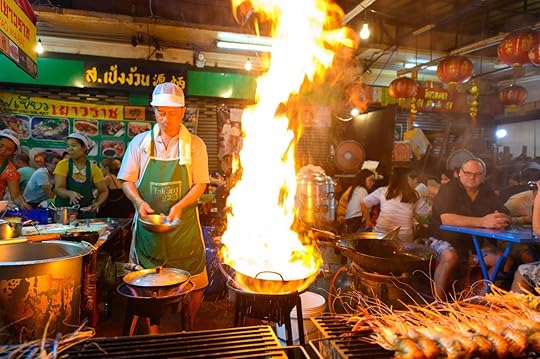
Photo: Brostock/Shutterstock
Bangkok has some of the best Chinese food in the world outside of China, and the Yaowarat market is where to get it. Yaowarat is Bangkok’s Chinatown, and it’s full of some of the best street food options in the entire city. Mainly, you’ll want to stick to Yaowarat Road and the parallel Charoen Krung Road, but don’t be afraid to venture down some smaller alleys and market lanes. You’ll find food options like bird’s nest soup and suckling pig here. To broaden your culinary horizons even further, Bangkok’s Little India neighborhood is just around the corner on Phahurat Road.
For the best food scene in Yaowarat, you’ll want to hit the street in the evening when most of the vendors are out. The mornings and afternoons are great for browsing the shopping markets, when clothes, accessories, souvenirs, and other items are sold in abundance.
Where: Yaowarat Rd, Krung Thep Maha Nakhon, Thailand
2. Wang Lang Market

Photo: Phawat/Shutterstock
If you’re looking for the widest and most diverse assortment of Thai street food, you can’t do better than the Wang Lang Market. Located at Wang Lang Pier, the market is open from 9:00 AM to 5:00 PM every day. Vendors lining the street outside Siriraj Hospital offer a tempting array of Thai desserts, grilled and fried pork, fish, chicken, grilled bananas, and many other delicious Thai snacks.
Where: 45 Arun Amarin Rd, Khwaeng Siriraj, Khet Bangkok Noi, Krung Thep Maha Nakhon 10700
3. Taling Chan Floating Market
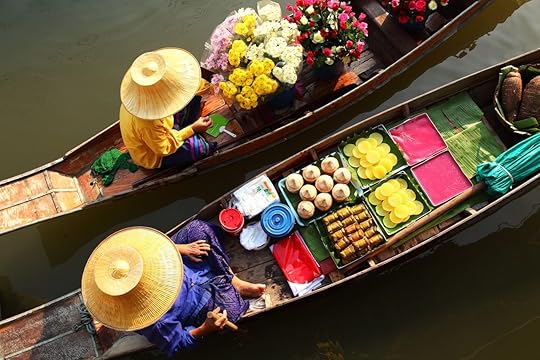
Photo: c sa bum/Shutterstock
Taling Chan Floating Market comes as advertised. Located seven miles outside the city, the market consists of several wooden boats docked along the riverbank cooking shrimp, crab, and other fresh seafood on miniature barbecues. Eating freshly caught seafood by the river is a tradition in Bangkok, and there’s no better place to do it than a floating market. Here, you sit at wooden platforms and low tables along the river where you’re served directly by the merchants preparing the food. There are also Thai musicians on hand playing traditional songs while you eat, lending even more ambience to the experience. If dining by the water leaves you longing to take to the river yourself, you can hire a longtail boat to tour the neighboring canals for the perfect post-meal excursion. The market is only open on Saturdays and Sundays from 8:00 AM to 5:00 PM.
Where: Taling Chan, Bangkok 10170
4. Silom Soi 20
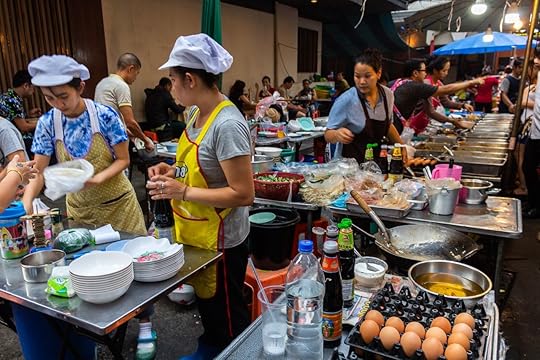
Photo: Dino Geromella/Shutterstock
Located in Bangkok’s central business district, this is one of the most convenient street food markets in the city. Given its proximity to many of Bangkok’s businesses, and the sheer volume of people trafficking Soi Convent Road, this is one of the biggest markets in Bangkok — and that means an abundance of options. Silom Soi 20 is half a mile south of the center of the Silom business district, and sells plenty of great Thai curries, chicken, rice, sweets, and snacks, especially between 6:00 AM and 9:00 AM when the road is closed to traffic and transformed completely into a market.
Where: Soi Silom 20, Khet Bang Rak, Krung Thep Maha Nakhon 10500
5. Talat Phlu

Photo: Vassamon Anansukkasem/Shutterstock
Given the ubiquitousness and popularity of street food in Bangkok, it makes sense that there would be designated awards honoring the best of the best. When it comes to the city’s premier food markets, Talat Phlu is among the most decorated. Several stalls in the Talat Phlu market have received local Thai awards for their dishes. Some of them, like one famous street cart that serves award-winning kanom buang yuan (a type of crepe), can’t be missed. Plaques and accolades praising its fare adorn the nearby street polls. The market is also known for having some of the best sticky rice and durian in the city.
It’s open day and night, and straddles the train tracks coming from Wongwian Yai, making it convenient for both locals and travelers.
Where: Talat Phlu, Thon Buri, Bangkok 10600
6. Maeklong Railway Market
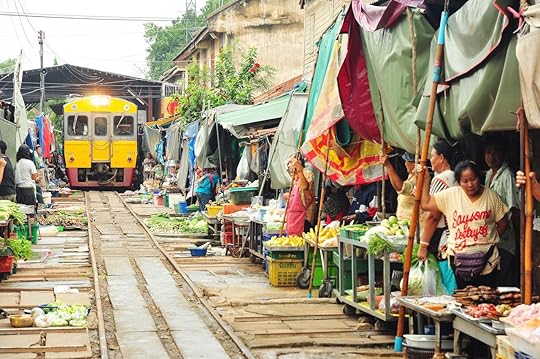
Photo: i viewfinder/Shutterstock
True to its name, the Maeklong Railway Market is located right on top of the train tracks just down the street from the Maeklong Railway Station, and it has been in business since 1905. When officials constructed a railway on the grounds of the market, that market didn’t disappear. It simply adapted to its changing circumstances. Vendors and merchants continue to set up their wares on the train tracks, and when the train whistle blows, the vendors remove their goods from the tracks, pull down their umbrellas, and wait patiently for the train to pass. When it does pass, it will come unnervingly close to you, but please resist the urge to reach out and touch it, or grab a last-minute Instagram photo.
Clothing and accessories are sold at this market, but you won’t find a treasure trove of souvenirs as you might at other markets. Food is the primary attraction here, with enough Thai sweets, meat, seafood, veggies, fruits, and drinks to tide you over for a while. It’s also important to note that the market is located outside the city, but (surprise, surprise), it’s easily accessible by train.
Where: Mae Klong, Mueang Samut Songkhram District, Samut Songkhram 75000
7. Chatuchak Weekend Market
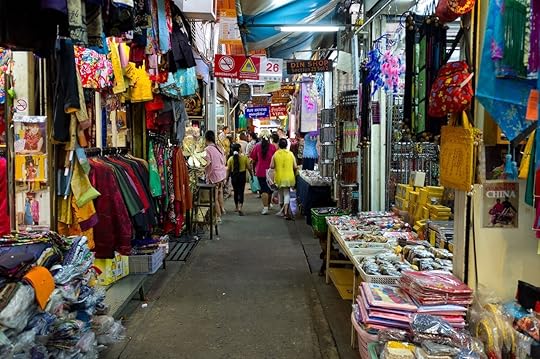
Photo: Pumidol/Shutterstock
The largest market in Bangkok, you might get more than you bargained for at the Chatuchak Weekend Market. It would probably take you months to see everything Chatuchak has to offer, and since it’s only open on weekends, you’ll have to be pretty efficient. As you may expect, you can buy pretty much everything here — from meats, drinks, and snacks to art, clothing, and jewelry. It might look like there are thousands of seasoned shoppers marching deliberately up and down the rows of stalls, but there’s a good chance most of them are probably just as lost as you. And that’s okay.
Keep your eyes out for the desserts, including chocolate-dipped bananas, crepes, and brownies, as well as coconut ice cream stands that serve ice cream inside your own personal coconut. For some sense of direction, make sure to take one of the free maps from the information kiosks. You’ll still get lost, but at least you might actually find your way out of the maze of vendors before sundown.
The market is open every Friday from 6:00 PM to midnight, and Saturday and Sunday from 9:00 AM to 6 PM.
Where: Kamphaeng Phet 2 Rd, Chatuchak, Bangkok 10900 

More like this: 7 destinations you’d never expect to have amazing street food scenes
The post 7 best street food and shopping markets in Bangkok appeared first on Matador Network.

German town offers $1 million

To put an end to a conspiracy theory that bloomed from a joke made in 1993, and to make itself a little more visible to potential tourists, the city of Bielefeld in Germany is offering 1 million euros (about $1.1 million) to anyone who can prove it does not exist.
Bielefeld and its very real 340,000 residents have been the butt of a 26-year-old joke-turned-conspiracy theory, when in 1993, a student named Achim Held sarcastically posted “Bielefeld? There’s no such thing” on the Usenet messaging system — an early form of internet forums. The post was prompted by Held’s experience at a party in the city of Kiel. When a guest from Bielefeld showed up, neither Held nor other party guests had ever heard of the city.
The joke made its way on the modern internet and was picked up by paranoid individuals, some who go as far as suggesting that Bielefeld actually does not exist, but is merely access to Atlantis, while others suggest that there are little green men who disguise their spaceship as Bielefeld University to hide their existence from humans.
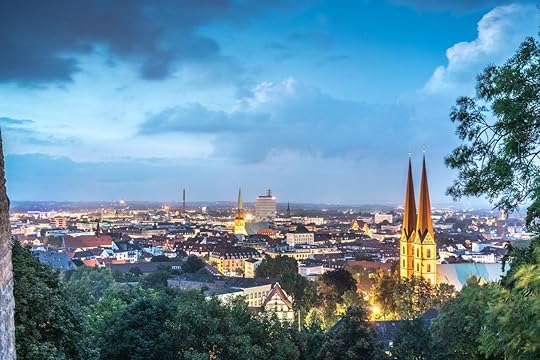
The city of Bielefeld — or is it? (Photo: Bielefeld JETZT/Facebook)
No matter what your theory is, if you want to enter the competition, you must submit evidence that the city of Bielefeld does not exist to Bielefeld Marketing by September 5. According to the competition website, entries can take the form of videos, text, or pictures, and “the pearls of your wisdom must be incontrovertible.” Proving the city’s nonexistence might be a fun exercise, but it’s likely an impossible one. The marketing company said, “We are 99.99 percent sure that we can refute any proof.” 

More like this: Your next German vacation should be in Rheingau wine country
The post German city offers $1.1 million to anyone who can prove it doesn’t exist appeared first on Matador Network.

Brazil president blames fires

Far from taking any responsibility for the fires raging in the Amazon, Brazilian President Jair Bolsonaro is putting the blame on non-governmental, environmental organizations. Without any supporting evidence, he alleges that they intentionally started the fires to punish him for cutting their funding.
While speaking at a steel industry conference, he said, “On the question of burning in the Amazon, which in my opinion may have been initiated by NGOs because they lost money, what is the intention? To bring problems to Brazil.” He first uttered the claim on a Facebook Live broadcast on Wednesday, saying “everything indicates” that NGOs were responsible, though failed to supply any evidence. When asked for proof, he replied that it was just his feelings.
The NGOs hit back, with Marcio Astrini of Greenpeace Brazil saying, “This is a sick statement, a pitiful statement. Increased deforestation and burning are the result of his anti-environmental policy.”
Indeed, many of the fires are said to have been started by those clearing land for farming and logging — an initiative begun by Bolsonaro, who wants to use the rainforest for industrial activity.
So far, there has been around 73,000 fires in Brazil in 2019, which is nearly double that of 2018. More than half of them have been in the Amazon.
The Amazon provides over 20 percent of the world’s oxygen, but Bolsonaro, who calls climate change a hoax, thinks efforts to curb deforestation of the rainforest are foreign attempts to halt Brazil’s economic development. 

More like this: The best places in America to try forest bathing
The post Brazilian president falsely claims Amazon fires were started by environmental groups to make him look bad appeared first on Matador Network.

Matador Network's Blog
- Matador Network's profile
- 6 followers



